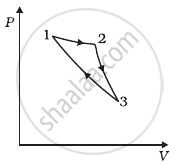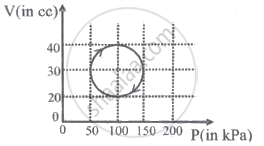Advertisements
Advertisements
Question
Three copper blocks of masses M1, M2 and M3 kg respectively are brought into thermal contact till they reach equilibrium. Before contact, they were at T1, T2, T3 (T1 > T2 > T3). Assuming there is no heat loss to the surroundings, the equilibrium temprature T is (s is specific heat of copper)
Options
`T = (T_1 + T_2 + T_3)/3`
`T = (M_1T_1 + M_2T_2 + M_3T_3)/(M_1 + M_2 + M_3)`
`T = (M_1T_1 + M_2T_2 + M_3T_3)/(3(M_1 + M_2 + M_3))`
`T = (M_1T_1s + M_2T_2s + M_3T_3s)/(M_1 + M_2 + M_3)`
Solution
`T = (M_1T_1 + M_2T_2 + M_3T_3)/(M_1 + M_2 + M_3)`
Explanation:
Let the equilibrium temperature to be found be T. Now, we consider T to be greater than T1 and T2 but smaller than T3.
Since there is no loss of heat energy. Hence, we get,
Heat lost by M3 = Heat regained by M1 + Heat regained by M2 So, we get,
⇒ M3s (T3 – T) = M1s (T – T1) + M2s (T – T2)
Dividing both sides by s, we get,
⇒ M3 (T3 – T) = M1 (T – T1) + M2 (T – T2)
Opening the brackets and solving for T, we get,
⇒ M3T3 – M3T = M1T – M1T1 + M2T – M2T2
⇒ M3T3 + M1T1 + M2T2 = M1T + M2T + M3T
⇒ `T = (M_1T_1 + M_2T_2 + M_3T_3)/(M_1 + M_2 + M_3)`
APPEARS IN
RELATED QUESTIONS
Find the change in the internal energy of 2 kg of water as it is heated from 0°C to 4°C. The specific heat capacity of water is 4200 J kg−1 K−1 and its densities at 0°C and 4°C are 999.9 kg m−3 and 1000 kg m−3 respectively. Atmospheric pressure = 105 Pa.
A solar cooker and a pressure cooker both are used to cook food. Treating them as thermodynamic systems, discuss the similarities and differences between them.
The isothermal bulk modulus of a perfect gas at pressure P is numerically equal to ____________.
An ideal gas undergoes four different processes from the same initial state (figure). Four processes are adiabatic, isothermal, isobaric and isochoric. Out of 1, 2, 3 and 4 which one is adiabatic.

Consider a cycle followed by an engine (Figure)
1 to 2 is isothermal
2 to 3 is adiabatic
3 to 1 is adiabatic

Such a process does not exist because ______.
- heat is completely converted to mechanical energy in such a process, which is not possible.
- mechanical energy is completely converted to heat in this process, which is not possible.
- curves representing two adiabatic processes don’t intersect.
- curves representing an adiabatic process and an isothermal process don’t intersect.
Write the mathematical equation for the first law of thermodynamics for:
Isothermal process
A system is taken through a cyclic process represented by a circle as shown. The heat absorbed by the system is ______.

If one mole of monoatomic gas `(gamma=5/3)` is mixed with one mole of diatomic gas `(gamma=7/5)`, the value of γ for the mixture is ______.
What work will be done, when 3 moles of an ideal gas are compressed to half the initial volume at a constant temperature of 300 K?
If the adiabatic ratio for a gas is 5/3, find the molar specific heat capacity of the gas at (i) constant volume (ii) constant pressure.
